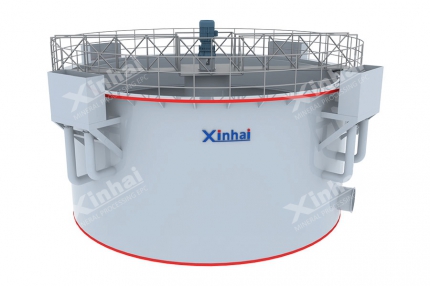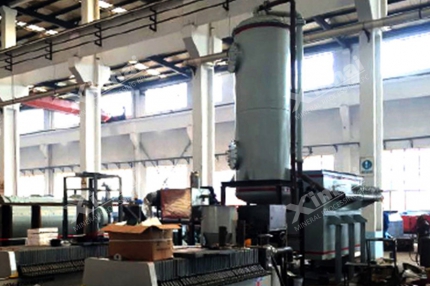With the large-scale exploitation of the gold mine, the refractory gold ore has become the main resource of the gold industry. "Refractory" generally refers to the mineral is difficult to separate and smelt, namely the conventional or single method is hard to achieve extraction, which needs several concentrating and smelting methods. Refractory gold ores must be pretreated firstly, and the commons pretreatment methods include roasting oxidation, hot-pressure oxidation, bacterial oxidation and chemical oxidation and so on. Raw ore pretreatment means to separate gold-bearing minerals in advance, expose the gold ore fully, then remove harmful substances or change properties, eliminate its bad effect on gold leaching process.
In recent years, Xinhai undertook various kinds of refractory gold ore dressing projects. Today, we selected three cases of refractory gold ore dressing for you to refer.
Gansu Arsenic and Antimony-bearing Gold Ore Dressing Project
Xinhai undertook its mineral processing EPC service in 2013. According to the experimental analysis, Xinhai Mining Research & Design Test Center found that the main elements of the raw ore as follows:

Xinhai Mining Research & Design Test Center tried several mineral processing tests, such as conventional cyanidation test, oxidation pretreatment - cyanidation test, roasting - cyanidation test, then reached different conclusions.
 (Flow of oxidation pretreatment - cyanidation test)
(Flow of oxidation pretreatment - cyanidation test)From the analysis of conventional cyanidation test, the leaching rate of gold ore was only 18.30~23.53%. So, the gold ore of this project was not only contained arsenic and antimony, but also contained fine particle size, which was extremely difficult to concentrate. The results of conventional cyanidation test were as follows:

From the analysis of oxidation pretreatment - cyanidation test, the leaching rate of gold ore was increased by 63.64-81.18%. It can be seen that the pretreatment operation eliminated the effects of arsenic and antimony on gold leaching, and achieved the purpose of improving the gold leaching rate. The results of oxidation pretreatment - cyanidation test were as follows:

From the result of roasting - cyanidation test, it can be seen that the gold leaching rates had large differences in roasting method and chemical oxidation method. The gold leaching rate of Z1 raw ore was 77.46%, gold leaching rate of Z1 tailings was 65.91%, gold leaching rate of B1 tailings reached 82.35%. The results of roasting - cyanidation test were as follows:

In summary, pretreatment - cyanidation method and roasting - cyanidation method can obtain high gold leaching rate, but roasting process was complicated and high-costed, so pretreatment - cyanidation method was the best choice for recovery. The oxidizing agent added to the pretreatment operation was non-toxic and tasteless, which wouldn't cause environmental pollution.
Qinghai High Mud and Arsenic-containing Fine Disseminated Type Gold Project
Xinhai undertook this project in 2014, and it belonged to high mud and arsenic-containing fine disseminated type gold deposit, which contained a large amount of arsenic, carbon and muddy minerals (chlorite, clay, montmorillonite and sericite), but lower sulfur content. So it was typical refractory gold ore. According to the complex ore properties, Xinhai carried out the exploration test of gold extraction process.
The useful element in the ore was gold, and silver can be recovered as the valuable element, other components had no recycling value. What's more, the visible gold in this project was mainly natural gold with fine particle, followed by micro-fine particle, and the disseminated types were mainly inclusive gold and exposed gold. This kind of ore was fit to flotate sulfide minerals for recovering the gold ore that wrapped in arsenopyrite and other sulfide minerals, then flotation tailings was sent to ball mill for regrinding, then the gold ore disseminated in gangue minerals was obtained with leaching operation. Therefore, Xinhai decided to adopt flotation - leaching combined process.
Gold-bearing sulfide flotation process can recover most gold ores in the raw ore, the recovery rate of crude gold was 62.64%, but the tailings still had high gold grade. This is because another part of gold ore was mainly embedded in gangue minerals, and the grain size was very fine. It was difficult to obtain the ideal index by the conventional flotation. Therefore, we carried on flotation tailings regrinding and leaching test to improve the recovery index of ore as much as possible.
The gold ore in flotation tailings was mainly extracted from gangue minerals, and the particle size was extremely fine. 80% re-grinding degree was controlled at -74 mm. Environmental gold extraction agent and sodium cyanide were often used as gold extraction agent. The results of flotation tailings direct leaching process were shown in the table.

It can be seen from the above table that the gold leaching rate increased with the increasing of grinding fineness firstly then decreased when we adopted sodium cyanide, but the gold leaching rate increased with the increasing of grinding fineness when we used environmental gold extraction agent. Taking grinding cost into consideration, we concluded that the suitable grinding fineness was -74 mu, accounting for 92.65%. Because this deposit contained organic carbon, the gold adsorption rates were both low in sodium cyanide and environmental gold extraction agent. Therefore, Xinhai adopted pre-carbon flotation before the tailings flotation process.

Compared to direct leaching process, the non-decarburization process can get 12 g/t gold grade and 20% gold leaching rate. Besides, the gold grade and gold leaching rate by pre-floatation decarburization were much higher than non-decarburization process.
Using flotation - flotation tailings regrinding- pre-carbon floatation – CIL process obtained better test indexes. The test indexes by using environmental gold extraction agent were similar with the sodium cyanide leaching gold test. Both can be used as an alternative medicine for toxic sodium cyanide, which was beneficial to energy conservation and environmental protection.
Malaysia High Arsenic and Sulphur Ultra-fine Gold, Silver Project
Xinhai undertook its mineral processing EPC in 2015. The ore was semioxide ore, gold and silver were the main recycling minerals. The gold particles were fine and mainly distributed in fine grains of the ore. Besides, there were 1.82% arsenic in the ore, which had the negative effect on the recovery of gold and silver.
As to high arsenic and sulfur gold mine, people often adopt roasting and bacterial oxidation process to remove arsenic, but both processes were complex and high-cost. However, oxidation pretreatment process eliminated the effect of arsenic and sulfur on gold leaching, obtained good recovery rate, economic and social benefits.
After testing and analysis, Xinhai Mining Research & Design Test Center got the results as follows:

The main recovery objects of this project were gold, silver and other elements. Since the mine contained 1.82% As, which was not beneficial to recover gold and silver.
Xinhai Mining Research & Design Test Center also tried different mineral processing solutions for this ore. The test results were as follows:

Compared with of ten mineral processing solutions, Xinahi concluded, IV can be chosen if the sales of flotation gold concentrates was not a problem (flotation + tailings flotation + cyaniding process), otherwise, X was the best if floatation gold concentrates cannot be used to sale (oxidation pretreatment + cyaniding process).
The raw ore used oxidation pretreatment + cyaniding process, -325 mesh grinding fineness accounted for 95%, pulp concentration of oxidation pretreatment was 30%, oxidant dosage was 60 kg/t, pretreatment time was 60 h, pulp concentration of cyaniding process was 35%, cumulative dosage of sodium cyanide reached 5 kg/t, cyaniding time was 48 h. finally, gold leaching rate was 87.97% and silver leaching rate of was about71.03%-71.19%.


 marketing@ytxinhai.com
marketing@ytxinhai.com  0086 13810327080
0086 13810327080 






































































































 CHAT
CHAT MESSAGE
MESSAGE











